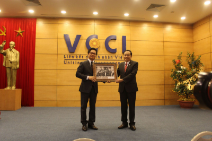Hanoi to develop creative tourism based on inherent advantages
By participating in creative tourism activities, visitors can gain a deeper understanding of local customs, art and culture through hands-on, meaningful interactions with local people.
In line with global trends, Hanoi is capitalizing on its unique advantages and potential to promote creative tourism, aiming to foster sustainable travel while preserving the city’s rich cultural identities.
Dr. Phung Thi Hang, a lecturer at the Faculty of Tourism under the National University of Economics, told The Hanoi Times that the concept of "creative tourism" was first introduced more than three decades ago (in 1993).
As defined by the United Nations Educational, Scientific and Cultural Organization (UNESCO), creative tourism is the direct experience and learning of the art, heritage or characteristics of a destination. Creative tourism helps visitors interact with local people and creates a vivid cultural experience.
"Many people believe that creative tourism is experiential tourism. However, it is not only a type of experiential tourism, but also involves the active role of tourists and local people through co-creating values, sharing knowledge and creative skills among stakeholders in the process of exploration based on the unique characteristics of the destination," Hang said.
 |
|
The "Vietnamese Village Tet" program in Hanoi's ancient Duong Lam Village allows foreign guests to immerse themselves in wrapping banh chung and gio. Photo: Hanoimoi |
She added that by participating in creative tourism activities, visitors can gain a deeper understanding of local customs, art and culture through hands-on, meaningful interactions with local people. "Tourists would live the life of the destination and create together as a member of the local community, instead of just enjoying and contemplating as in traditional tourism."
"Creative tourism emphasizes the connection and interaction between tourists and natural resources, culture and local people. Tourists have the opportunity to deeply understand and experience the traditions, lifestyles, customs, practices, local arts. They are encouraged to participate in the creation and exchange of knowledge and culture," Hang said.
She emphasized that interaction with tourists from many cultures with different experiences and values helps to preserve and maintain traditional cultural values and to create new cultural and artistic values.
Hang said Hanoi is the first city in Vietnam to become a member of UNESCO's Creative Cities Network and has demonstrated its position with the Hanoi Creative Design Festival, which has been held in four versions and has left a deep impression on tourists.
"In 2024, under the festival, people saw the handshake between travel companies, heritage sites, local authorities and the capital's Department of Culture to build new heritage discovery tours, creating special effects and emotions for both locals and tourists," Hang said.
More recently, on the occasion of the 80th anniversary of the founding of the Vietnamese People's Army (December 22, 1944-2024), Hanoi people and tourists flocked to Hoan Kiem Lake Walking Street to join young soldiers in singing songs about their homeland, peace and independence.
Many people became emotional when they saw the foreign visitors dancing and chanting "Vietnam - Ho Chi Minh" in the song "It's Like Seeing Uncle Ho on the Great Victory Day". "This further confirmed that Hoan Kiem Lake and the surrounding walking area have become a cultural hub and a popular destination in the capital," Hang added.
On the outskirts of Hanoi, Duong Lam Ancient Village in Son Tay Town is increasingly reinforcing its brand as a must-visit destination with the Doai Creative Cultural Space, the Vietnamese Village Tet program, which brings together ambassadors and foreigners working in the city each year.
In Ung Hoa District, Quang Phu Cau Incense Village has gone viral on social networks and in the international press with its typical image of bundles of incense sticks arranged in the shape of a map of Vietnam, making many tourists curious to visit.
"All of the above tourism products bear the mark of community creativity, when people know how to take advantage and use the value of cultural heritage to create creative tourism offerings," Hang told The Hanoi Times.
"The way tourists use technology throughout their journey to look up information, learn about destinations, use AI translation tools, or post statuses on social media platforms has helped spread the image of the destination. This is the way people and tourists co-create to develop tourism in a sustainable way," Hang said.








